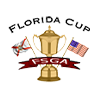Written by: Darin Green, Senior Director of Rules & Competitions
 The FSGA is in the middle of our Championship schedule and have conducted many competitions recently. Below are a few notable rulings from the past two weeks.
The FSGA is in the middle of our Championship schedule and have conducted many competitions recently. Below are a few notable rulings from the past two weeks.
No Play Zone
The Florida Open was held on two courses for the first two rounds and players played both courses before the 36-hole cut was made. The TwinEagles Club in Naples was one of the courses they played and the course had several conservation areas that were played as red penalty areas and no play zones. These areas were identified by many red stakes with green tops and white signs.
A red penalty area that is also a no play zone means that if a player’s ball is in the red penalty area, the player has all of the normal relief options under Rule 16 with the exception of playing the ball as it lies.
The 18th hole at The TwinEagles Club has a red penalty area and no play zone that runs the entirety of the left side of the hole. During the first round a player hit his tee shot into the no play zone and he found his ball. He did not notice the many red stakes with green tops or the white signs (he probably didn’t read the Notice to Players – Local Rules sheet either). He played his ball as it lies, but his ball did not exit the no play zone. He played the ball from its new location inside the no play zone and was able to get the ball out and it ended up near a cart path. He called in a rules official for help with his drop. During the conversation with the official, the player mentioned that he just played from within the red penalty area and the official explained that it was a no play zone and we have a problem. The official called me over the radio to confirm the ruling. We agreed that the player played twice from a wrong place, and we also agreed it was not a serious breach (significant advantage). The player was assessed two two-stroke penalties for playing from a wrong place, a total of four penalty strokes.
Lost and then Found
During the final round of the Florida Open, I was stationed on the 15th hole because we moved the tee markers up significantly to make the par 4 drivable for most players and there was out of bounds and a red penalty area near the putting green.
A professional was having a very good round going and he was moving up the leaderboard, on pace to earn nice check for his finish. Then his round started to fall apart, he made a bogey on the 13th and a double bogey on the 14th. He reached the 15th tee and decided to attempt to drive the green in hopes to get his round back on track. I lost his tee shot in the sun, but he seemed ok with it from his reaction. When the players parked their carts near the green, they began searching for a ball left of the green. I drove my cart up near them, started my timer, and joined in the search. All three players thought the ball should’ve been just left of the green. Unfortunately, the three-minute search time expired and the ball was lost. The player returned to the tee to play his third stroke which ended up just short of the green. When approached his ball, he was surprised to see two balls lying near each other. It turned out his original tee shot ended up just short of the green, not to the left of the green (there was a little hill blocking our view from where we were searching and where his original ball was).
At this point the player waved me back in to confirm the bad news. With empathy, I confirmed that original ball was lost due to the three-minute search time expiring and him playing another ball under stroke distance. Understandably, the player was very upset, but he calmed himself down and was able to get his ball up & down for a bogey 5.
“Hey, I Got It”
On the 15th hole at the Florida Open, a player hit his tee shot into a red penalty area just short and right of the green. His ball was in a dry area of the penalty area and was playable. There was a sign describing the vegetation in the area that was positioned in front of his ball and might interfere with his area of intended swing. The young player asked if he gets relief from it and I explained that he does not because his ball is in a red penalty area, but he could remove the sign if it is movable and won’t damage the course. The young player gave one tug on the side and it didn’t move. He said, “it’s in there pretty good, I’ll just play it as it.” Another player nearby said, “hey, I got it” and walked over gave the sign a strong tug and the sign came out of its hole. The player thanked him and played a great shot onto the green and made birdie. I replaced the sign back into the hole and no damage to the course occurred.
Yes, you can have other people help you move a movable obstruction or a loose impediment.
Stepped on His Ball
At the Parent-Child Championship a father/son duo was at their ball during play of a hole (not on the putting green) and the son accidentally stepped on his ball pushing it slightly into the ground. They thought that it might be a penalty; however, they weren’t sure. They played the ball as it lies and reported the facts to an official two holes later.
The official informed them that accidentally stepping on your ball in play, not while searching or when it is on the putting green, results in a one-stroke penalty for causing your ball to move. And, since they altered their lie and did not place the ball in the nearest most similar lie within one club-length not nearer the hole, they played from a wrong place which is a two-stroke penalty. When these two breaches of the rules happen, only the higher penalty is applied and the team was assessed a two-stroke penalty on the hole.
Three Seconds Late
At a junior match play tournament recently a player lost track of time on the practice range and had to rush to his starting tee. The players were in carts so there was a chance he might make it in time. The starter was watching the clock and as his tee time came to be, the player was pulling up to the tee, but not stopped. When the player stopped his cart, it was three seconds after his tee time. The starter informed the player that he incurred a loss of hole penalty and the match must head to the second hole.
When it comes to tee times, the Rules of Golf clarify that if a tee time is 8:00, those players must be present at the tee and ready to play. “Ready to play” is defined in the Rules as having a ball and a club. The FSGA has concluded that if a player is still driving their cart towards the starting tee, the player is not present at the tee or ready to play.
I look forward to sharing stories on the Rules of Golf on August 15th!





